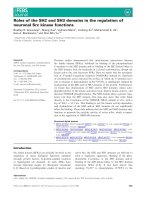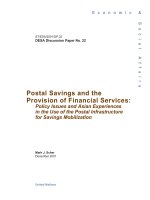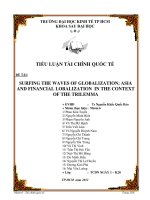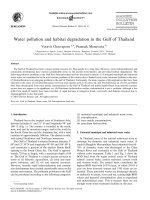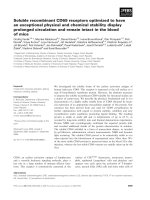Entrepreneurship and enterprises growth in the industrialization of private sector evidence from wenzhou
Bạn đang xem bản rút gọn của tài liệu. Xem và tải ngay bản đầy đủ của tài liệu tại đây (1.17 MB, 89 trang )
ENTREPRENEURSHIP AND ENTERPRISES
GROWTH IN THE INDUSTRIALIZATION OF
PRIVATE SECTOR: EVIDENCE FROM WENZHOU
YAN FEI
(MASTER OF SOCIAL SCIENCES), NUS
A THESIS SUBMITTED
FOR THE DEGREE OF MASTER OF SOCIAL
SCIENCES (BY RESEARCH)
DEPARTMENT OF ECONOMICS
NATIONAL UNIVERSITY OF SINGAPORE
2012
Table of Contents
Summary ........................................................................................................... iv
List of Tables ...................................................................................................... v
List of Figures ................................................................................................... vi
1.
Background ................................................................................................. 1
2.
The Theoretical Model ................................................................................ 4
3.
4.
2.1
Framework and Assumptions .......................................................... 4
2.2
Model Specification......................................................................... 8
2.3
Propositions ................................................................................... 17
The Empirical Investigation ...................................................................... 21
3.1
Empirical Literature Review and Hypotheses ............................. 21
3.2
Data Source .................................................................................. 28
3.3
The Empirical Model ................................................................... 35
3.4
Regression Analysis ..................................................................... 44
3.5
Overcoming Financial Constraint ................................................ 51
3.6
Transitional Background and Institutional Innovation ................ 56
Conclusions ............................................................................................... 67
Bibliography .................................................................................................... 72
Appendices ....................................................................................................... 78
iii
Summary
Wenzhou is historically famous for its entrepreneurs. With disadvantageous
initial conditions, however, strong industrial growth has occurred in the
Wenzhou region in the last two decades. In this paper, by applying the
occupational choice model which involves wealth evolution in an imperfect
credit market, we try to identify key factors behind the evolution of Wenzhou
private enterprises. Relying on a probabilistic firm survey that was carried out
in Wenzhou for three industries (shoes, eyeglasses and general equipment), we
identify through empirical analysis how the entrepreneurship plays its role and
what are the patterns of entrepreneurship in Wenzhou that have facilitated the
industrialization of private sector.
iv
List of Tables
Table 1: The distribution of the sampled firms by industries and regions ....... 29
Table 2: Main attributes of the sampled firms by industries ............................ 31
Table 3: Summary of Survey content............................................................... 33
Table 4: Revenue/Asset ratio and Risk measure by industries ........................ 38
Table 5: Personal information collected for entrepreneurs .............................. 41
Table 6: Estimated Effect of Initial Asset and Risk-taking on Profit ............... 47
Table 7: Source of Initial Funding for entrepreneurs ....................................... 55
Table 8: Enterprise Ownership when established ............................................ 61
v
List of Figures
Figure 1: Comparison between Wenzhou and national average ........................ 2
Figure 2: Dynamics of wealth evolution .......................................................... 16
vi
1.
Background
China’s substantial economic growth used to be attributable mainly to
township and village enterprises (TVEs) in the 1980s, the private sector
emerged as the new engine in the 1990s. According to Sonobe et al (2004),
“the heartland of this private sector growth was Zhejiang Province,
particularly in Wenzhou City. Although Wenzhou used to be a poor rural area,
it now ranks among the most prosperous cities in China due to its relatively
rapid economic growth in the 1980s and its explosive growth in the 1990s.”
In fact, Wenzhou had very disadvantageous initial conditions, such as limited
arable land, poor infrastructure and especially little support from the central
government. This region seemed to lack all the conditions necessary for
economic growth.
From 1949 till 1978, the central government only invested RMB559 million in
Wenzhou's infrastructure establishment, which was far below the national
average investment per capita. Consequently in the year 1978, as reported by
Wenzhou Municipal Bureau of Statistics, the gross output value of
state-owned industrial enterprises only took up 35.7% of the gross output of
all industrial enterprises in Wenzhou, which was far below 78%, the national
average percentage of state-owned industrial enterprises. Therefore, Wenzhou
had a strong tendency towards “privatization” as well as “marketization”, even
1
if this was against the background of “planned economy” at that time.
And yet, beginning from 1978, with the reforming and opening-up policy
implemented, Wenzhou had the opportunity to develop its private economy. In
the mid-to-late 1980s, strong industrial growth occurred in the Wenzhou
region (John, Edward and Shen (2007)). Almost all of the firms in these
industries were private in nature and most of them are small and medium
enterprises (SMEs). As a result of this rapid industrial expansion, the growth
rate of GDP in Wenzhou was far faster than the whole country – see Figure 1.
It was also shown in the figure that the GDP growth of Wenzhou had
experienced three major surges compared with national average right after the
years of 1979, 1987 and 1992. We will further explain this trend in the later
part of the study.
Figure 1 Comparison between Wenzhou and national average
2
Until the year 1990, according to Wenzhou Municipal Bureau of Statistics, the
gross output value of private industrial enterprises reached 82.8% of the gross
output of all industrial enterprises, picking up by 18.5 percentage points from
the reading in 1978. Moreover, this percentage reached 92.4% in 1997, and
had been staying above 90% since then. Notice that the national average of the
percentage had been only 50% to 60% from 2002 to 20081. Thus, as the center
of private sector activities in China, Wenzhou represents a very important area
for the study of entrepreneurship and enterprise growth. Moreover, it has been
widely acclaimed academically that the major characteristic of the Wenzhou
model of economic development has been the growth of private household
enterprises. (See Liu (1992), Parris (1993), Sonobe et al. (2004))
Why had Wenzhou economy experienced such a rapid growth during the last
two decades? What were the driving forces behind the industrialization in
Wenzhou? Focusing on entrepreneurship and enterprises, we will address
these issues in this paper.
Firstly in Section 2, by applying the occupational choice model, which
involves wealth evolution in an imperfect credit market, we will identify key
factors behind the evolution of Wenzhou private enterprises. Although
theoretical models, with certain assumptions aiming to reduce complexity in
1
National Bureau of Statistics, and Report for the Development of China’s Private Economy
(2008-2009)
3
setting, have their limitations in shedding light on the reality, we will tell an
interesting story on how individuals made its occupational choice to become
workers, constrained or unconstrained entrepreneurs and how their wealth
evolves to equilibrium. The propositions drawn from our theoretical model
will provide motivations for raising the empirical hypotheses in Section 3.
Relying on a firm survey that was carried out in Wenzhou for three industries
namely, shoes, eyeglasses and general equipment, we will also conduct
empirical tests and analysis in Section 3, and examine how entrepreneurship
played its role in Wenzhou enterprises.
2.
The Theoretical Model
2.1 Framework and Assumptions
In this section, we present an occupational choice model, some of Wenzhou’s
entrepreneurial features are incorporated into this model. However, we are not
going to simulate a comprehensive Wenzhou model in this theoretical part, as
the purpose is to generally discuss on the impact of entrepreneurship and
initial wealth on individuals’ entrepreneurial choice and equilibrium wealth, so
as to provide some inspirations for the following empirical work. Thus, we
will not specify much on macro factors such as government, institutional
constraint or national reforming stages in this part.
4
Our model relates to literatures on occupational choice and wealth evolution
with imperfect credit market, by referring to earlier works such as Evans and
Jovanovic (1989), Banerjee and Newman (1993), Galor and Zeira (1993) and
Aghion and Bolton (1997), and the more recent ones such as Ellis and
Bernhardt (2000) and Buera (2006).
Similar to those literatures, we have both initial wealth and entrepreneurship
playing an important role in our model. However, Evans and Jovanovic (1989)
only consider a static occupational choice model while we introduce dynamic
generations to the model. Unlike Banerjee and Newman (1993), we avoid
discussion on production technologies of entrepreneurs, because Wenzhou
entrepreneurs were initially not technology innovators.
Despite having a
much simpler model here, we reach a similar propositions structure as that in
Buera (2006).
Our model is closest to that of Galor and Zeira (1993) in setting. While they
suggest that individuals pay education cost to accumulate human capital which
later offers higher wages, we in this paper propose that individuals need to pay
startup costs to become entrepreneurs with entrepreneurial production
technology. The human capital in their model plays the similar role as the
entrepreneurship in our model. Galor and Zeira derived the similar curve as
ours. Their conclusion points to the income distribution among skilled and
5
unskilled workers, whereas ours derives different wealth convergence point
among entrepreneurs and workers.
For simplicity, we treat Wenzhou as a small open economy and adopt a partial
equilibrium model to investigate the factors in the growth process of Wenzhou
private enterprises. Similar to Ellis and Bernhardt (2000), the utility function
is in the Cobb-Douglas form which ensures that people have constant saving
and consumption behaviors. As a main input factor, Wenzhou’s labor market is
featured by surplus labor force with prolonged low wage rate, even if the labor
productivity increases (John, Edward and Shen (2007)). Hence, we assume the
wage to be exogenous and consisted in entrepreneur’s cost function.
At the beginning of the economic reform, the entrepreneurs in Wenzhou were
growing under discrimination and had more access into the unregulated small
commodities2 market. All these goods were lower-end products that relied on
“copied” technologies. Firms were taking advantage of the transitional feature
of economy and initiating institutional innovation. Overall, at the early stage
of growth, the entrepreneurs in Wenzhou were not technology innovators but
institutional innovators, a concept that we will discuss about in the empirical
part, together with Wenzhou’s transitional background and the role of local
2
Refers to small commodities that are with dispersed production, various and fast-changing
consumption patterns, and not included in the state plan of goods. It consists of articles of daily use,
hardware, part of the cultural goods, etc.
6
government.
We adopt the entrepreneurial choice model under liquidity constraints used in
Evans and Jovanovic (1989), where capital was essential for starting a
business and liquidity constraints tended to exclude those with insufficient
funds at their disposal. However, the setting was somewhat different in our
model. Owing to their specific social network, goodwill and family
relationship, Wenzhou entrepreneurs were able to overcome the liquidity
constraints while starting a business. Hence, even though liquidity seemed
tight initially as formal financial market was underdeveloped, this informal
financing actually played a very prominent role. In fact, according to the
Zhejiang branch of CBRC (China Banking Regulatory Commission), the
interest rate in Wenzhou informal financing market was much higher
compared to that of formal financing. This observation vividly demonstrated
that while formal financial channels were limited, entrepreneurs had actually
paid and were willing to pay a higher rate in order to borrow the money from
these informal channels.
Therefore, to sum up, the following assumptions are made in modeling the
Wenzhou entrepreneurship and enterprise growth:
A1: The utility function is Cobb-Douglas.
7
A2: Worker’s wage is exogenous, the cost of employing workers is
incorporated in entrepreneur’s cost function.
A3: The entrepreneurs are not new technology innovators.
A4: The entrepreneur may face budget constraint for starting a business, but
they shall be able to borrow from either formal or informal markets based on
their own network and reputation.
2.2 Model Specification
The economy contains a continuum population of measure one, and there are
countable periods. Each individual lives for one period, and reproduce a new
agent at the end of period. The preference of agent is traditionally “warm-glow”
(see Andreoni (1989)) with form:
u(ct , bt 1 ) ct bt 11
(1)
Each agent has consumption of ct , and leave bt 1 to the next period as
bequests to their children without any regard to whether their children really
benefit from the bequest. This assumption is similar to that of Banerjee and
Newman (1993) and Galor and Zeira (1993) so that individuals are living for
one period only, and thus and over generations, the evolution of wealth is
determined by the warm-glow bequest motive that is not forward-looking.
During lifetime, the agent chooses its consumption ct this period and bequest
bt 1 to the next period to maximize its utility. Each agent has a labor force one,
8
and make occupational choice based on their initial wealth between an
entrepreneur and a worker, the former is not necessarily to be a successful one
(it will also be affected by his entrepreneurial ability, i.e. entrepreneurship that
will be specified later), while the latter does not require any capital investment.
Also assume that there exists a critical point b , when one ends up with
bequest bt b , he chooses to be an entrepreneur, otherwise a worker. In the
following part, we will be solving the maximization problems for both
entrepreneur and worker.
(1) Worker’s maximization
As a worker, one could get a wage of nt ; combined with the initial wealth
which has safety return rate rt , a worker’s life time budget totals up to
nt rt bt .
Each worker maximizes its utility subject to its life time budget constraint:
1
Max ct bt 1
ct , bt 1
s.t. ct bt 1 nt rt bt
(2)
Solving for the maximization problem above is equivalent to the problem
below:
Max log ct (1 )log bt 1
ct , bt 1
s.t. ct bt 1 nt rt bt
(3)
9
Form the Lagrangian: L log ct (1 ) log bt 1 (ct bt 1 nt rt bt )
F.O.C:
ct :
ct
bt 1 :
0
1
0
bt 1
(4)
(5)
Rearrange equations (4) and (5), we have:
bt 1 1
ct
(6)
Substitute (6) back into the life-time budget constraint: ct bt 1 nt rt bt , we
have
ct (nt rt bt )
bt 1 (1 )(nt rt bt )
(7)
(8)
where the exogenous stands for a fixed proportion that consumption takes
up in the life-time budget.
(2) Entrepreneur’s maximization
1
The entrepreneurs actually have the same utility function u(ct , bt 1 ) ct bt 1 ,
the only difference is that their budget constraint changes from nt rt bt to yt ,
which is the profit after they optimize their production. Thus for
entrepreneurs,
bt 1 (1 ) yt
(9)
To become an entrepreneur, one needs to pay startup cost Ct ( ) , with
10
Ct' ( ) 0 , lim Ct ( ) 0 , lim Ct ( ) . [low,high ] measures the
0
heterogeneous entrepreneurship, and plays a critical role in our model. Ellis
and Bernhardt (2000) distinguished agents by two characteristics, namely,
their initial wealth inheritances and their personal costs of undertaking a
project. Different from their assumption, in our analysis, we extract the
personal costs as a function of entrepreneurship , which actually determines
their cost C . This cost includes all expenses incurred during production investing in fixed asset, employing workers, etc. Hence, here we distinguish
the agents by their initial wealth b and entrepreneurship (entrepreneurial
ability) . The rationale is consistent with the assumption made by Ellis and
Bernhardt (2000) that start-up costs reflect innate entrepreneurial efficiency
and are uncorrelated with inherited wealth. Here, entrepreneurship could be
the ability involved with entry cost, such as the ability to borrow “cheaper”
money based on personal relationship and reputation, the capability of
bargaining in a deal to reduce cost, and specifically as for Wenzhou’s
entrepreneurship, we will also take into account “institutional innovation”,
meaning the extent to which the entrepreneurs can “work” the state socialist
system to their own advantage. We will specify on “institutional innovation”
further in the later part.
After paying the startup cost, the entrepreneurs are available with technology
f (kt ) , with f (kt ) 0 , f (kt ) 0 , lim f (kt ) . For simplicity, we
kt 0
11
assume f (kt ) kt and 0 1.
Credit market is imperfect; formal lending is rare and capital resource for
informal lending is limited. Based on Wenzhou’s scenario, entrepreneurs’
initial funding source include shareholders’ investment, family and
relative’s support, personal loans, banks and rural credit unions, whereby
the last two as formal financing channels were very few, and the rest
informal channels were mainly relationship based. We assume what one
can borrow is proportional to his personal wealth wit , which serves as
collateral and adds to the person’s goodwill. Such a proportion is t -1,
where t measures the weighted development level of both formal and
informal financing market, the latter could be viewed as the scale of
finance pool formed by social network. We also assume that one could
borrow at the interest rate of rt , which is the weighted average of both
formal and informal interest rates.
Thus, from both the formal and informal lending markets, entrepreneurs
could borrow up to the amount of (t 1)bt with rt as the interest rate.
Give an agent type (bt , ) , entrepreneur faces a maximization problem:
Max: yt f (kt ) rt [kt Ct ( ) bt ]
kt
s.t:
kt Ct ( ) t bt
(10)
Form the Lagrangian L kt rt [kt Ct ( ) bt ] (kt Ct ( ) t bt )
12
1
We have L / kt kt rt 0 ; L / 0 , 0 ,
L
0.
(11)
Based on the Lagrangian functions above, together with our assumptions,
mathematically we summarize three occupational choices below:
Case 1: Unconstrained entrepreneur
If 0 , i.e. the constraint is not binding, there will be internal solution
derived:
L / kt kt
1
rt kt
1
rt 0 kt ( )
rt
1
1
(12)
This is the case when an individual has initial wealth above b (value of
this critical point will be derived later), he could be an unconstrained
entrepreneur who have optimal investment in entrepreneurial production
and lend out redundant capital with return rt .
1
Therefore, substitute kt ( )1 back into entrepreneur’s profit function:
rt
yt kt rt [kt Ct ( ) bt ]
(13)
we have
y (1 )( )
rt
u
t
1
rt bt rt Ct ( )
if bt b
(14)
Case 2: Constrained entrepreneur
If 0 , i.e. the constraint is binding, there will be corner solution
derived:
kt Ct ( ) t bt 0 kt t bt Ct ( )
13
This is the case when an entrepreneur is with initial wealth below b , he
has to borrow to attain the constrained investment level.
Again, substitute kt t bt Ct ( ) back into entrepreneur’s profit function
(13), we have
ytr (t bt Ct ( )) (t 1)rb
t t
if b bt b
(15)
bt b
(16)
Case 3: The last choice as a worker:
yt l nt rb
t t
if
Thus, as discussed in the three cases above, the forms of income functions
((14), (15) and (16)) depend on one’s wealth constraint. It is the initial
wealth b that determines one’s occupational choice to be a constrained
entrepreneur, unconstrained entrepreneur or a worker.
Combine the three income functions (14), (15) and (16):
1 1 C ( )
u
r
.
When yt yt , it can be derived that b ( )1 t
t
t
rt
(17)
The evolution of individual wealth:
Applying
bt 1 (1 ) yt ,
bt 1 (1 )(nt rt bt )
to the result of the
maximization problem (i.e the three income functions (14), (15) and (16)), the
dynamic evolution of personal initial wealth over generations is:
bt 1 (1 )[(1 )( )1 rt bt rt ct ( )]
rt
if bt b
(18)
14
bt 1 (1 )[(t bt ct ( )) (t 1)rb
t t ] if b bt b
(19)
bt 1 (1 )(nt rt bt )
(20)
if
bt b
Here we discuss how the dynamics in the individual wealth evolution are
determined:
Equation (18) and (20) are straightforward: bt 1 as a function of bt , the
coefficient of bt is (1 )rt in both cases, according to the initial definition
of , rt , it can be derived that 0 (1 ) r 1 , thus equation (20) and (18)
are straight lines with slope less than 1 and their intersections with the 45° line
corresponded to l and h respectively, whereby
(1 )[(1 )( ) rt ct ( )]
rt
bt 1 bt h
1 (1 )rt
1
(21)
which is derived by solving for simultaneous equations of (18) and the 45°
line bt 1 bt .
Equation (18) is more complicated,
1
bt 1 / bt (1 )
(1 )(t 1)rt
t (t bt ct ( ))
When bt 1 / bt 0 , it can be derived that bt ( )
rt
(22)
1
1
1
t
Ct ( )
t
, which is
also the local maximum of equation (19), the same as the value of b , as
derived in (17). The result demonstrated that the intersection between (18) and
(19) is also the maximum of equation (18).
As 1 1 0 ,
15
1
2
(1 )
/ bt (1 )
0
t (t bt ct ( ))
t
t ( 1)(t bt ct ( ))
For bt (b, b ) , bt 1 / bt 0 , and when bt increases, bt 1 / bt
decreases accordingly, i.e. the slope of equation (18) has been decreasing until
being equal to zero when bt b - see Figure 2.
Thus for constrained entrepreneur, the bt 1 (bt ) function (equation 19) curve
has been increasing on [b, b ] until it reaches its local maximum, plus the fact
that (19) intersects (18) and (20) at b and b , which, according to
Intermediate Value Theorem, equation (19) intersects the 45° line at some
point due to the continuity, and the point corresponds to w , thus the existence
of w has been proved.
Therefore, following the analysis above, we figure the wealth evolution below:
Figure 2: Dynamics of wealth evolution
16
Equation (18), (19) and (20) all intersect the 45° line, the three intersections
corresponds to h , w and l respectively, where h is the convergent point
of entrepreneurs’ wealth level, w is the “poverty trap” wealth level
(definition of which will be further elaborated later on) , and l is the
convergent point of workers’ wealth level. All of them depend on the level of
entrepreneurship , capital intensive rate , interest rate r , financial
deepening rate .
In sum, being deduced from individual dynamics, as shown in Figure 2, the
economy converges to a long-run equilibrium in which the population is
divided into two groups: entrepreneurs with wealth level h and workers with
wealth level l , the critical threshold wealth level w( ) is the “poverty trap”
which distinguishes entrepreneurs from workers. Thus, although the agents
made their initial occupation choice based on their bequest from previous
generation, in the end it was both the bequest b and entrepreneurship that
determine their equilibrium wealth.
2.3 Propositions
Now, we have the following Propositions with proof.
Proposition 1:
For [low,high ] , there exists a threshold wealth level,
such that for initial wealth wt w( ) , individuals choose their occupation as
17
entrepreneurs and then become successful entrepreneurs. Individuals with
initial wealth level smaller than w( ) will ultimately become workers.
Proof: With reference to figure 2, when wt w( ) , there will be two cases:
(1) wt l w( ) : In Zone X: When the curve bt 1 (bt )
is above the 45° line,
i.e. bt 1 bt : bt rises, and this process continues until equilibrium is reached
at B, where bt 1 bt .
(2) l wt w( ) : In Zone Y: When the curve bt 1 (bt )
is below the 45° line,
i.e. bt 1 bt : bt decreases, and this process continues until equilibrium is
reached at B, where bt 1 bt .
Thus B is the convergence point of wealth for workers.
Similarly, when wt w( ) , there will be two cases:
(1) In Zone Z: When the curve bt 1 (bt )
is above the 45° line, i.e. bt 1 bt :
bt rises, and this process continues until equilibrium is reached at A, where
bt 1 bt .
(2) In Zone W: When the curve bt 1 (bt )
is below the 45° line, i.e. bt 1 bt :
bt decreases, and this process continues until equilibrium is reached at A,
where bt 1 bt , the convergence point for entrepreneurs, and to which
individuals reached are defined as successful entrepreneurs.
Proposition 2: We call the wealth level w( ) the poverty trap value of
wealth. w( ) is decreasing in entrepreneurship, i.e. w( ) 0 . The effect of
18
entrepreneurship on w( ) will be magnified when the financial system is less
developed.
Proof:
w is the horizontal coordinate to which the intersection between equation (18)
and bt 1 bt corresponds, meaning when bt 1 bt , bt 1 bt w .
According to (22),
bt 1 / bt
bt w
(1 )t (t bt ct ( )) 1 (1 )(t 1)rt 1
(1 )t (t bt ct ( )) 1 (1 )(1 t )r
(t bt ct ( )) 1
(1 )(1 t )r
(1 )t
1; 0 (1 )(1 t )r 1
(1 )(1 t )r 0
and (1 )t 0
(1 )(1 t )r
0
(1 )t
t bt ct ( ) (
bt
ct ( )
t
w( ) /
(1 )(1 t )r 11
)
(1 )t
1 (1 )(1 t )r 11
(
) w( )
(1 )t
t
w( ) ct ( ) 1 ct ( )
.
.
t
ct ( )
(23)
As defined before,
and
1
ct ( )
0,
0
t
w( ) / 0
(24)
According to (23), it is shown that when (reflecting financial deepening
level and personal capability to access capital) is smaller, w( ) / will be
19

